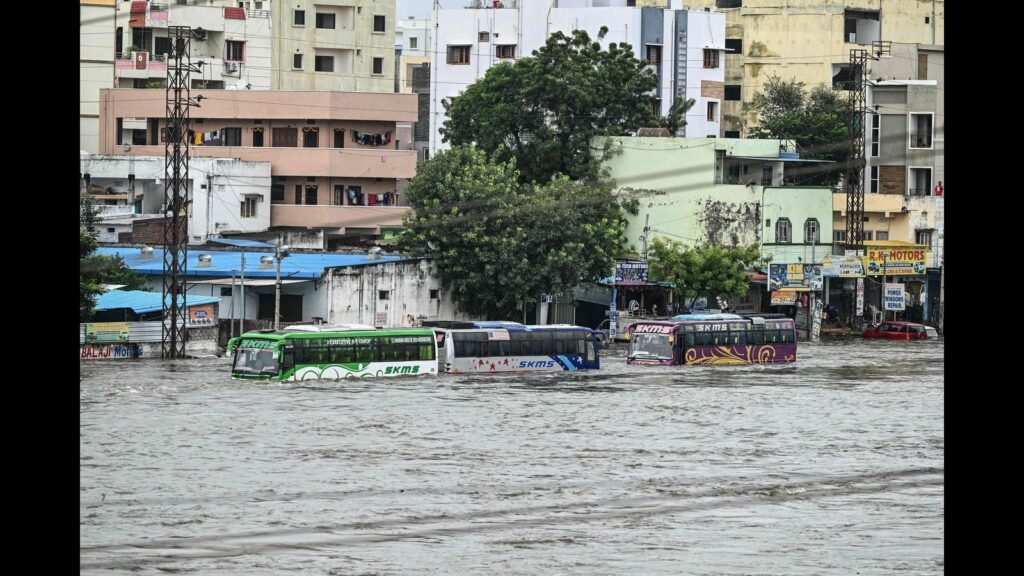
The torrential rains across India this monsoon once again exposed the deep vulnerabilities of its cities. Similar scenes of rain-wrought havoc played out across many cities, including metropolitan Kolkata, Delhi, Mumbai, and Bengaluru. Urban centers that power India’s economy are now routinely drowning under their own weight — victims of poor planning and climate complacency. With climate-crisis-induced extreme rainfall events projected to surge by 43% by 2030, urban flooding is no longer an aberration — it’s a chronic crisis demanding urgent and systemic action. According to a 2025 World Bank report, India suffers average annual flood-related losses of nearly $4 billion, a figure expected to rise sharply as climate risks escalate and cities expand without adequate planning.

It is, therefore, urgent for the government to devise a robust multi-pronged strategy that can strengthen stormwater management systems, restore natural drainage channels, and build climate-resilient infrastructure across urban India.
Such a strategy must harness the role of key stakeholders in addressing urban flooding. The private sector, through its technical expertise, sector-specific knowledge and ability to design cutting-edge innovations, can devise effective long-term solutions to two of the major challenges. Governments are faced with — lack of cost-effective technological interventions and large-scale monitoring of vulnerabilities.
A recurring challenge for municipalities is the management of stormwater and solid waste, which often clog city drains and aggravate flooding. India generates 62 million tonnes of municipal solid waste annually, of which less than 60% is collected and around 15% processed. Inadequate collection and processing of debris block drainage channels in cities.
Businesses can complement government efforts by creating promising market-based solutions for waste management and water resilience. For instance, ITC’s “Wellbeing Out of Waste” initiative (WOW) has demonstrated scalable models of waste segregation, collection, and recycling in multiple cities, reducing the load on municipal systems by collecting thousands of tonnes of dry waste, estimating up to 63,700 MT in 2024. This initiative covered over 25 million citizens across India in 6.4 million households. Similarly, startups like Recykal are leveraging digital platforms to connect waste generators with recyclers, ensuring that plastic and construction debris are monetised rather than dumped into storm drains. Scaling up such impact ventures, with policy support and municipal contracts, can directly reduce the severity of urban flooding events.
The challenge of managing excess stormwater also demands innovative engineering and financial solutions. Post-monsoon relief packages sought by state governments are now running into thousands of crores. In September 2025 alone, Telangana reported losses of nearly 5,018.72 crore as torrential rains inundated residential areas, energy networks, commercial centres, and agricultural fields. For businesses, investing in flood resilience is not just corporate responsibility but economic necessity.
Companies such as Infosys and Wipro have already taken significant steps in this direction. Under its ESG Vision 2030, Infosys has developed an extensive Rainwater Harvesting and Groundwater Recharge programme, constructing more than 370 deep-injection wells and 35 lakes and ponds across its campuses. — together capable of recharging over 18 million tonnes of groundwater. Wipro, in partnership with Biome Environmental Trust, ACWADAM and MapUnity, has launched an Integrated Water Management Program in Sarjapur. This initiative combines internal water efficiency measures with externally focused Participatory Aquifer Mapping (PAQM), supporting the installation of recharge wells, revival of defunct open wells, and promoting community-led aquifer governance in Bengaluru. Scaling up such private-sector-led interventions across industrial clusters, commercial hubs, and residential complexes can substantially ease the pressure on overstretched municipal drainage. systems.
However, effective implementation of such technological solutions depends on accurate and granular monitoring of rainfall patterns, drainage flows, and ground saturation levels to assess the precise scale of. intervention required. India’s existing hydromet network is inadequate for this purpose — with less than one rain gauge for every 500 sq km, the country has significant ground to cover in developing reliable urban flood. monitoring systems.
As of July 2025, the India Meteorological Department (IMD) operates approximately 1,008 Automatic Weather Stations (AWS), 1,382 Automatic Rain Gauges (ARGs), and 200 Agro-AWS across the country. The existing network is woefully inadequate for hyperlocal forecasting, especially in urban areas prone to flooding. For instance, Delhi, with a population exceeding 20 million, currently has just 18 AWS in operation. Indian cities would require significant upgrades to additional AWS and ARGs to effectively track hyperlocal rainfall, drainage capacity, and groundwater recharge rates.
The private sector can help meet this gap by investing in big data analytics, AI-driven hydrological modelling, and low-cost IoT sensor networks that can continuously monitor stormwater levels in real time. Startups like ClimaCell (Tomorrow.io) are using satellite data, machine learning, and crowd-sourced inputs from mobile devices to deliver street-level weather forecasts. Similarly, companies such as SatSure are working with Indian states to integrate high-resolution satellite imagery with on-ground flood risk assessments. Private sector-designed flood sensors — akin to Siemens Mobility and EarthSense’s Zephyr air quality sensors — could allow local authorities to monitor rainfall intensity, waterlogging, and Drainage blockages at the neighborhood scale, enabling timely interventions before floods spiral out of control.
Finally, as businesses themselves are often directly implicated — with construction, real estate, and industrial projects encroaching on wetlands and floodplains — they must align practices with the climate-resilient urban agenda, by adhering to stricter environmental standards, integrating nature-based solutions such as urban wetlands and permeable pavements, and ensuring supply chains are designed with resilience at their core.
In India’s urgency to address urban flooding, the private sector’s role has never been more critical. By building scalable innovations, financing resilience, and aligning their own growth with climate-compatible practices, they can transform Indian cities from climate-vulnerable hotspots to resilient urban ecosystems.
Aparna Roy is fellow and lead, Climate Change and Energy, ORF. The views expressed are personal




